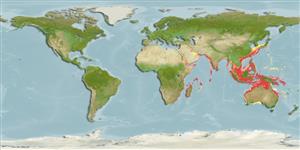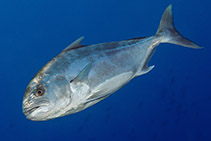Seriolina nigrofasciata (Rüppell, 1829)
Blackbanded trevally
Adicionar as suas observações no Fish Watcher
| Native range | All suitable habitat | Point map | Year 2050 |

|
| This map was computer-generated and has not yet been reviewed. |
| Seriolina nigrofasciata AquaMaps Data sources: GBIF OBIS |
Adicionar o seu Fotografias e vídeos
Pictures | Imagem do GoogleSeriolina nigrofasciata
Picture by Greenfield, J.
Pictures | Imagem do GoogleSeriolina nigrofasciata
Picture by Greenfield, J.
Thailand country information
Common names:
[No common name]
Occurrence: native
Salinity: marine
Abundance: | Ref:
Importance: minor commercial | Ref:
Aquaculture: | Ref:
Regulations: | Ref:
Uses: no uses
Comments: Known from Ko Sichang (Chon Buri), Gulf of Thailand, Songkhla and Andaman Sea (Ref. 37773). Also Ref. 3287.
National Checklist:
Country Information: https://www.cia.gov/library/publications/resources/the-world-factbook/geos/th.html
National Fisheries Authority:
Occurrences: Occurrences Point map
Main Ref: Monkolprasit, S., S. Sontirat, S. Vimollohakarn and T. Songsirikul, 1997
National Database:
Occurrence: native
Salinity: marine
Abundance: | Ref:
Importance: minor commercial | Ref:
Aquaculture: | Ref:
Regulations: | Ref:
Uses: no uses
Comments: Known from Ko Sichang (Chon Buri), Gulf of Thailand, Songkhla and Andaman Sea (Ref. 37773). Also Ref. 3287.
National Checklist:
Country Information: https://www.cia.gov/library/publications/resources/the-world-factbook/geos/th.html
National Fisheries Authority:
Occurrences: Occurrences Point map
Main Ref: Monkolprasit, S., S. Sontirat, S. Vimollohakarn and T. Songsirikul, 1997
National Database:
Common names from other countries
Classificação / Names Nomes comuns | Sinónimos | Catalog of Fishes(Género, Espécies) | ITIS | CoL | WoRMS | Cloffa
> Carangiformes (Jacks) > Carangidae (Jacks and pompanos) > Naucratinae
Etymology: Seriolina: Latin word diminutive with the meaning of a large earthenware pot (Ref. 45335).
More on author: Rüppell.
Etymology: Seriolina: Latin word diminutive with the meaning of a large earthenware pot (Ref. 45335).
More on author: Rüppell.
Environment: milieu / climate zone / depth range / distribution range Ecologia
marinhas; estuarina associadas(os) a recifes; intervalo de profundidade 20 - 150 m (Ref. 30573). Tropical; 38°N - 35°S, 20°E - 163°E
Distribuição Países | Áreas FAO | Ecossistemas | Ocorrências | Point map | Introduções | Faunafri
Indo-West Pacific: Red Sea and East Africa to Japan, Australia and Solomon Island. Southeast Atlantic: southeast coast of South Africa (Ref. 3197).
Tamanho / Peso / Idade
Maturity: Lm ? range ? - ? cm
Max length : 77.5 cm TL macho/indeterminado; (Ref. 30504); common length : 50.0 cm TL macho/indeterminado; (Ref. 5450); peso máx. Publicado: 5.2 kg (Ref. 3287)
Max length : 77.5 cm TL macho/indeterminado; (Ref. 30504); common length : 50.0 cm TL macho/indeterminado; (Ref. 5450); peso máx. Publicado: 5.2 kg (Ref. 3287)
Descrição breve Chaves de identificação | Morfologia | Morfometria
Espinhos dorsais (total) : 8 - 9; Raios dorsais moles (total) : 30 - 37; Espinhos anais: 2; Raios anais moles: 15 - 18. Color bluish grey to black dorsally, white to dusky below; 5-7 dark oblique bands or blotches on young disappear with age. Posterior spines of dorsal fin minute or embedded in large adults; first anal spine usually embedded. Gill rakers are mostly rudiments. Grooves of caudal peduncle present dorsally and ventrally. Maxilla reaching below rear margin of the eyes.
Mainly in offshore reefs on the continental shelf (Ref. 30573, 48635), on rocky bottoms (Ref. 11230). Non-schooling. Juveniles under weed rafts and adults are sometimes seen with the large planktivores such as whale sharks (Ref. 48635). Adults feed on demersal fishes, cephalopods, and shrimp (Ref. 11441). Excellent food fish (Ref. 3197); marketed fresh and dried salted (Ref. 3287).
Life cycle and mating behavior Maturidade | Reprodução | Desova | Ovos | Fecundidade | Larvas
Referência principal
Upload your references | Referências | Coordenador : Smith-Vaniz, William F. | Colaboradores
Paxton, J.R., D.F. Hoese, G.R. Allen and J.E. Hanley, 1989. Pisces. Petromyzontidae to Carangidae. Zoological Catalogue of Australia, Vol. 7. Australian Government Publishing Service, Canberra, 665 p. (Ref. 7300)
Categoria na Lista Vermelha da IUCN (Ref. 130435: Version 2024-2)
Preocupação menor (LC) ; Date assessed: 09 March 2015
Ameaça para o homem
Harmless
Utilização humana
Pescarias: pouco comercial; peixe desportivo: sim
FAO(pescarias: produção; publication : search) | FishSource | Sea Around Us
Mais informação
Population dynamics
Parâmetros de crescimento
Max. ages / sizes
Length-weight rel.
Length-length rel.
Frequência de comprimento
Mass conversion
Recrutamento
Abundância
Parâmetros de crescimento
Max. ages / sizes
Length-weight rel.
Length-length rel.
Frequência de comprimento
Mass conversion
Recrutamento
Abundância
Life cycle
Reprodução
Maturidade
Fecundidade
Desova
Spawning aggregations
Ovos
Desenvolvimento dos ovos
Larvas
Dinâmica larvar
Reprodução
Maturidade
Fecundidade
Desova
Spawning aggregations
Ovos
Desenvolvimento dos ovos
Larvas
Dinâmica larvar
Physiology
Body composition
Nutrients
Consumo de oxigénio
Tipo de natação
Velocidade de natação
Visual pigments
Fish sound
Diseases & Parasites
Toxicity (LC50s)
Body composition
Nutrients
Consumo de oxigénio
Tipo de natação
Velocidade de natação
Visual pigments
Fish sound
Diseases & Parasites
Toxicity (LC50s)
Human related
Aquaculture systems
Perfis para aquacultura
Estirpes
Ciguatera cases
Stamps, coins, misc.
Aquaculture systems
Perfis para aquacultura
Estirpes
Ciguatera cases
Stamps, coins, misc.
Ferramentas
Bio-Quiz | E-book | Guia de campo | Chaves de identificação | Ferramenta auxiliar de frequências de comprimento | Ferramenta sobre a história de vida | Mapa dos pontos | Classification Tree
| Catch-MSY |
Relatórios especiais
Descarregue XML
Fontes da internet
Aquatic Commons | BHL | Cloffa | BOLDSystems | Websites from users | Consultar FishWatcher | CISTI | Catalog of Fishes(Género, Espécies) | DiscoverLife | ECOTOX | Faunafri | Fishtrace | GenBank(genoma, nucleotídeo) | GloBI | GOBASE | | Google Books | Google Scholar | Google | IGFA World Record | MitoFish | Bases de dados nacionais | Otolith Atlas of Taiwan Fishes | PubMed | Reef Life Survey | Scirus | SeaLifeBase | Árvore da vida | Wikipedia(ir para, procurar) | World Records Freshwater Fishing | Registo zoológico
Estimates based on models
Preferred temperature (Ref. 115969): 21.9 - 28.3, mean 27 (based on 911 cells).
Phylogenetic diversity index (Ref. 82804): PD50 = 1.0000 [Uniqueness, from 0.5 = low to 2.0 = high].
Bayesian length-weight: a=0.02344 (0.01170 - 0.04697), b=2.93 (2.75 - 3.11), in cm Total Length, based on LWR estimates for this species & (Sub)family-body (Ref. 93245).
Nível Trófico (Ref. 69278): 4.2 ±0.57 se; based on food items.
Resiliência (Ref. 120179): Médio, tempo mínimo de duplicação da população 1,4 - 4,4 anos (Assuming tm=2-4).
Fishing Vulnerability (Ref. 59153): Moderate to high vulnerability (51 of 100).
Climate Vulnerability (Ref. 125649): High vulnerability (61 of 100).




